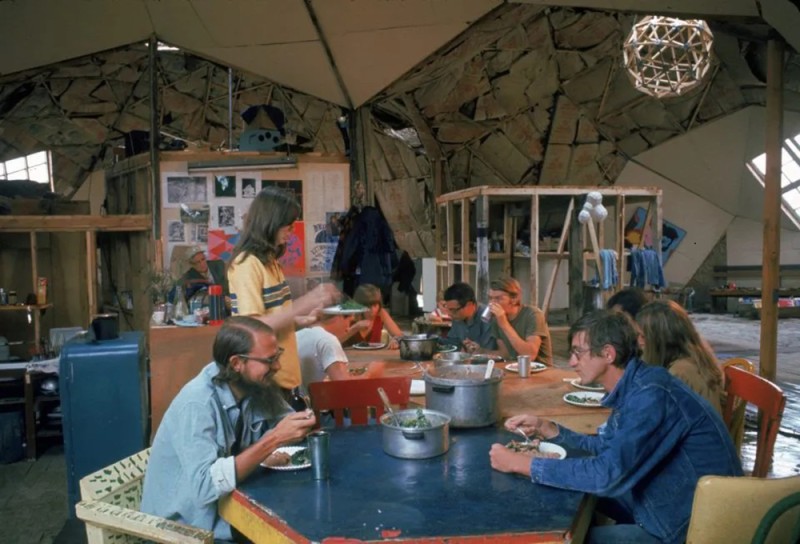
• 20世纪六七十年代,集体生活在嬉皮士运动的浪潮中兴起。如今,Z世代和千禧一代正愈发倾向于与朋友或家人共同购房——这一选择并非受反主流文化的驱动,而是他们以务实态度应对高房价、学生债务以及抵押贷款利率。
20世纪60年代和70年代是集体生活最丰富多彩、繁荣的时期之一。彼时,年轻一代——婴儿潮一代——创立了公社,欢迎任何愿意摒弃主流文化、逃离城市化的人加入。
《纽约时报》1970年的一篇文章指出,集体生活也是一种低成本的生活选择。公社——很大程度上受到嬉皮士运动(一场基于和平、爱、自由和个人主义的反主流文化运动)的影响——通过集中资源支付房租、食物和公用事业费用来降低生活成本。多人合租不仅降低了租金,也无需单独购置电器、支付公用事业费用和其他生活费用。

五六十年前,集体生活曾风靡一时。如今,我们正见证集体生活的复兴,这种生活方式在Z世代群体中愈发常见——不过,背后的原因却大不相同。
根据国家抵押贷款保险公司(National Mortgage Insurance Corporation)的最新报告,近三分之一的Z世代表示愿意与朋友或家人共同出资购房(即“合买”);18%的千禧一代也持有相同观点。2024年OpenDoor的报告还指出,超过四分之三的首次购房者与父母、兄弟姐妹、朋友、伴侣甚至同事共同购房。
这绝非仅仅是潜在发展趋势。房地产经纪人和其他住房专家告诉《财富》杂志,他们已在各自的住房市场中看到这一趋势的显现。
TikTok和Instagram上也充斥着Z世代和千禧一代共同购房的视频。
全美范围内的集体生活现象
康涅狄格州费尔菲尔德县科威国际不动产(Coldwell Banker)房地产经纪人帕蒂·库珀(Patti Cooper)告诉《财富》杂志,自疫情以来房价一路飙升,在她所处的房地产市场中,合买趋势正愈发盛行。根据美国房地产经纪人协会(NAR)的数据,抵押贷款利率仍接近7%,美国人需年收入达到六位数才能负担得起中位数房价的住房,目前这一数字已超过42.2万美元。
她表示,父母已出售自有住房,并与子女共同出资购置带有独立姻亲公寓的独栋住宅。虽然这种模式成效颇佳,但年轻一代仍希望拥有自己的空间。
“兄弟姐妹也因租金上涨而选择合买住房,这样更为划算,”她补充道,“另一个原因是学生贷款债务使个人申请抵押贷款的难度增加。”
马萨诸塞州Property Checker公司的首席房地产研究员兼分析师埃琳娜·诺瓦克(Elena Novak)也向《财富》杂志透露,过去两年间,更多Z世代和千禧一代购房者选择“联合购置”房产。
“起初,是两兄弟姐妹或关系亲密的大学好友凑钱购买一套单人无力承担的公寓,”诺瓦克说,“如今,我看到有同事三人组,甚至还有四人小团体在寻找房源。”
“相较于五年前,这种趋势的增长态势一目了然,”她继续说道,“当时除已婚夫妇外,合买住房的情况基本不存在。”
根据Better Place Design and Build首席执行官巴·扎克海姆(Bar Zakheim)的说法,Z世代的另一种常见合住选择是在父母的房产上建造附属住宅单元(ADUs)。
扎克海姆对《财富》杂志表示:“从经济层面考量,这根本难以实现,尤其是在我们所在的圣地亚哥这样住房成本位居全国前列的地区。”合买或建造附属住宅单元“让他们能够以远低于直接购房的价格解决住房问题。”
专家表示,虽然我们可能不会再经历类似嬉皮士运动的浪潮,但Z世代和千禧一代的合买趋势将会持续下去。
“与20世纪70年代的反主流文化集体生活实验不同——这些实验伴随更广泛的文化变革兴起,后因经济好转而消退——如今的合买住房现象源于严峻的经济现实。”诺瓦克表示。高房价和抵押贷款利率等迹象“都表明合买住房并非只是短暂尝试,它极有可能成为一种永久的、常态化的购房途径。”(*)
译者:中慧言-王芳
• 20世纪六七十年代,集体生活在嬉皮士运动的浪潮中兴起。如今,Z世代和千禧一代正愈发倾向于与朋友或家人共同购房——这一选择并非受反主流文化的驱动,而是他们以务实态度应对高房价、学生债务以及抵押贷款利率。
20世纪60年代和70年代是集体生活最丰富多彩、繁荣的时期之一。彼时,年轻一代——婴儿潮一代——创立了公社,欢迎任何愿意摒弃主流文化、逃离城市化的人加入。
《纽约时报》1970年的一篇文章指出,集体生活也是一种低成本的生活选择。公社——很大程度上受到嬉皮士运动(一场基于和平、爱、自由和个人主义的反主流文化运动)的影响——通过集中资源支付房租、食物和公用事业费用来降低生活成本。多人合租不仅降低了租金,也无需单独购置电器、支付公用事业费用和其他生活费用。
五六十年前,集体生活曾风靡一时。如今,我们正见证集体生活的复兴,这种生活方式在Z世代群体中愈发常见——不过,背后的原因却大不相同。
根据国家抵押贷款保险公司(National Mortgage Insurance Corporation)的最新报告,近三分之一的Z世代表示愿意与朋友或家人共同出资购房(即“合买”);18%的千禧一代也持有相同观点。2024年OpenDoor的报告还指出,超过四分之三的首次购房者与父母、兄弟姐妹、朋友、伴侣甚至同事共同购房。
这绝非仅仅是潜在发展趋势。房地产经纪人和其他住房专家告诉《财富》杂志,他们已在各自的住房市场中看到这一趋势的显现。
TikTok和Instagram上也充斥着Z世代和千禧一代共同购房的视频。
全美范围内的集体生活现象
康涅狄格州费尔菲尔德县科威国际不动产(Coldwell Banker)房地产经纪人帕蒂·库珀(Patti Cooper)告诉《财富》杂志,自疫情以来房价一路飙升,在她所处的房地产市场中,合买趋势正愈发盛行。根据美国房地产经纪人协会(NAR)的数据,抵押贷款利率仍接近7%,美国人需年收入达到六位数才能负担得起中位数房价的住房,目前这一数字已超过42.2万美元。
她表示,父母已出售自有住房,并与子女共同出资购置带有独立姻亲公寓的独栋住宅。虽然这种模式成效颇佳,但年轻一代仍希望拥有自己的空间。
“兄弟姐妹也因租金上涨而选择合买住房,这样更为划算,”她补充道,“另一个原因是学生贷款债务使个人申请抵押贷款的难度增加。”
马萨诸塞州Property Checker公司的首席房地产研究员兼分析师埃琳娜·诺瓦克(Elena Novak)也向《财富》杂志透露,过去两年间,更多Z世代和千禧一代购房者选择“联合购置”房产。
“起初,是两兄弟姐妹或关系亲密的大学好友凑钱购买一套单人无力承担的公寓,”诺瓦克说,“如今,我看到有同事三人组,甚至还有四人小团体在寻找房源。”
“相较于五年前,这种趋势的增长态势一目了然,”她继续说道,“当时除已婚夫妇外,合买住房的情况基本不存在。”
根据Better Place Design and Build首席执行官巴·扎克海姆(Bar Zakheim)的说法,Z世代的另一种常见合住选择是在父母的房产上建造附属住宅单元(ADUs)。
扎克海姆对《财富》杂志表示:“从经济层面考量,这根本难以实现,尤其是在我们所在的圣地亚哥这样住房成本位居全国前列的地区。”合买或建造附属住宅单元“让他们能够以远低于直接购房的价格解决住房问题。”
专家表示,虽然我们可能不会再经历类似嬉皮士运动的浪潮,但Z世代和千禧一代的合买趋势将会持续下去。
“与20世纪70年代的反主流文化集体生活实验不同——这些实验伴随更广泛的文化变革兴起,后因经济好转而消退——如今的合买住房现象源于严峻的经济现实。”诺瓦克表示。高房价和抵押贷款利率等迹象“都表明合买住房并非只是短暂尝试,它极有可能成为一种永久的、常态化的购房途径。”(*)
译者:中慧言-王芳
• Communal living surged in the 1960s and ‘70s as part of the hippie movement. Today, Gen Z and millennials are increasingly turning to co-buying homes with friends or family—not for countercultural reasons, but as a practical response to high housing prices, student debt, and mortgage rates.
The 1960s and ‘70s were one of the most colorful and plentiful examples of communal living. Younger generations—baby boomers, at the time—developed communes that were welcoming of anyone willing to reject mainstream culture and escape urbanism.
It was also a lower-cost living option. Communes—largely influenced by the hippie movement, a rejection of mainstream culture based on peace, love, freedom, and individualism—pooled resources for rent, food, and utilities, driving costs down, according to a 1970 article by The New York Times. Houses were shared among several people, pushing down rent costs and eliminating the need for separate appliances, utilities, and other living expenses.
Communal living was popular 50 to 60 years ago. Now, we’re witnessing a resurgence of communal living, which has become increasingly common among Gen Z—but for very different reasons.
According to a recent report by the National Mortgage Insurance Corporation, nearly one-third of Gen Zers said they’re open to pooling funds and purchasing a home with friends or family, a practice known as co-buying; 18% of millennials said the same. A 2024 OpenDoor report also said more than three in four first-time homebuyers purchased their house with parents, siblings, friends, romantic partners, and even colleagues.
This isn’t just a would-be trend. Realtors and other housing experts told Fortune they’re already seeing this movement show up in their own housing markets.
TikTok and Instagram are also filled with videos of Gen Z and millennials who have bought homes together.
Communal living across the U.S.
Patti Cooper, a Fairfield County, Conn.-based real-estate agent for Coldwell Banker, told Fortune the co-buying trend is becoming increasingly popular in her housing market since housing prices have skyrocketed since the pandemic. Mortgage rates are still nearly 7%, and Americans need to make six figures to afford a median-priced home, which is currently more than $422,000, according to the National Association of Realtors (NAR).
Parents have sold their homes and combined their income with their children to buy single-family homes with separate in-law apartments, she said. While it can work out nicely, younger generations still want their own space.
“Siblings are also buying houses together because of the rising cost of rents. It’s more affordable,” she added. “The other reason is that student loan debt makes it harder to qualify for a mortgage by yourself.”
Elena Novak, a lead real-estate researcher and analyst at Property Checker based in Massachusetts, also told Fortune more Gen Z and millennial buyers have been “banding together” to buy homes in the past two years.
“At first, it was two siblings or close college friends pooling savings to snag a condo that neither could afford alone,” Novak said. “Now I’m seeing triads of coworkers or even small house shares of four people on the hunt.”
“The uptick is unmistakable compared to just five years ago,” she continued, “when co-buying was essentially nonexistent outside of married couples.”
Another common co-living option for Gen Zers, according to Bar Zakheim, CEO of Better Place Design and Build, is to build accessory dwelling units (ADUs) on their parents properties.
“The math just doesn’t add up, especially where we are in San Diego with some of the highest housing costs in the country,” Zakheim told Fortune. Co-buying or building an ADU “allows them to find a housing solution for themselves at a fraction of the cost of buying a home.”
And while we may not have something exactly like the hippie movement again, we can expect the trend of Gen Z and millennial co-buying to continue, experts say.
“Unlike the counterculture communal living experiments of the 1970s—which blossomed alongside a broader cultural shift and then faded as the economy strengthened—today’s co-buying is rooted in hard economics,” Novak said. Signs like high home prices and mortgage rates “points to co-buying being more than a fleeting experiment. It’s likely to become a permanent, normalized path to ownership.”

